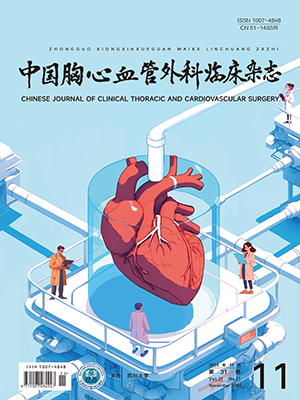| 1. |
McGuinness SP, Parke RL, Drummond K, et al. A multicenter, randomized, controlled phase Ⅱb trial of avoidance of hyperoxemia during cardiopulmonary bypass. Anesthesiology, 2016, 125(3): 465-473.
|
| 2. |
郝星, 黑飞龙, 侯晓彤. 2020年中国心外科手术和体外循环数据白皮书. 中国体外循环杂志, 2021, 19(5): 257-260.He X, Hei FL, Hou XT. White book of Chinese cardiovascular surgery and extracorporeal circulation in 2020. Chin J Extrac Circ, 2021, 19(5): 257-260.
|
| 3. |
Lagier D, Fischer F, Fornier W, et al. Effect of open-lung vs. conventional perioperative ventilation strategies on postoperative pulmonary complications after on-pump cardiac surgery: The PROVECS randomized clinical trial. Intensive Care Med, 2019, 45(10): 1401-1412.
|
| 4. |
Futier E, Constantin JM, Paugam-Burtz C, et al. A trial of intraoperative low-tidal-volume ventilation in abdominal surgery. N Engl J Med, 2013, 369(5): 428-437.
|
| 5. |
PROVE Network Investigators for the Clinical Trial Network of the European Society of Anaesthesiology, Hemmes SN, Gama de Abreu M, et al. High versus low positive end-expiratory pressure during general anaesthesia for open abdominal surgery (PROVHILO trial): A multicentre randomised controlled trial. Lancet, 2014, 384(9942): 495-503.
|
| 6. |
Young CC, Harris EM, Vacchiano C, et al. Lung-protective ventilation for the surgical patient: International expert panel-based consensus recommendations. Br J Anaesth, 2019, 123(6): 898-913.
|
| 7. |
Schreiber JU, Lancé MD, de Korte M, et al. The effect of different lung-protective strategies in patients during cardiopulmonary bypass: A meta-analysis and semiquantitative review of randomized trials. J Cardiothorac Vasc Anesth, 2012, 26(3): 448-454.
|
| 8. |
Kuo CY, Liu YT, Chen TS, et al. A nationwide survey of intraoperative management for one-lung ventilation in Taiwan: Time to accountable for diversity in protective lung ventilation. BMC Anesthesiol, 2020, 20(1): 236.
|
| 9. |
Fischer MO, Courteille B, Guinot PG, et al. Perioperative ventilatory management in cardiac surgery: A French nationwide survey. Medicine (Baltimore), 2016, 95(9): e2655.
|
| 10. |
Bignami E, Di Lullo A, Saglietti F, et al. Routine practice in mechanical ventilation in cardiac surgery in Italy. J Thorac Dis, 2019, 11(4): 1571-1579.
|
| 11. |
Mathis MR, Duggal NM, Likosky DS, et al. Intraoperative mechanical ventilation and postoperative pulmonary complications after cardiac surgery. Anesthesiology, 2019, 131(5): 1046-1062.
|
| 12. |
Güldner A, Kiss T, Serpa Neto A, et al. Intraoperative protective mechanical ventilation for prevention of postoperative pulmonary complications: A comprehensive review of the role of tidal volume, positive end-expiratory pressure, and lung recruitment maneuvers. Anesthesiology, 2015, 123(3): 692-713.
|
| 13. |
中华医学会麻醉学分会"围术期肺保护性通气策略临床应用专家共识"工作小组. 围术期肺保护性通气策略临床应用专家共识. 中华麻醉学杂志, 2020, 40(5): 513-519.Chinese Society of Anesthesiology Task Force on Clinical Application of Perioperative Lung-Protective Ventilation Strategies. Expert consensus on clinical application of perioperative lung-protective ventilation strategies. Chin J Anesthesiol, 2020, 40(5): 513-519.
|
| 14. |
Lellouche F, Delorme M, Bussières J, et al. Perioperative ventilatory strategies in cardiac surgery. Best Pract Res Clin Anaesthesiol, 2015, 29(3): 381-395.
|
| 15. |
Hedenstierna G, Edmark L. Effects of anesthesia on the respiratory system. Best Pract Res Clin Anaesthesiol, 2015, 29(3): 273-284.
|
| 16. |
Sato H, Nakamura K, Baba Y, et al. Low tidal volume ventilation with low PEEP during surgery may induce lung inflammation. BMC Anesthesiol, 2016, 16(1): 47.
|
| 17. |
Michalopoulos A, Anthi A, Rellos K, et al. Effects of positive end-expiratory pressure (PEEP) in cardiac surgery patients. Respir Med, 1998, 92(6): 858-862.
|
| 18. |
Deng QW, Tan WC, Zhao BC, et al. Intraoperative ventilation strategies to prevent postoperative pulmonary complications: A network meta-analysis of randomised controlled trials. Br J Anaesth, 2020, 124(3): 324-335.
|
| 19. |
Eisner MD, Thompson BT, Schoenfeld D, et al. Airway pressures and early barotrauma in patients with acute lung injury and acute respiratory distress syndrome. Am J Respir Crit Care Med, 2002, 165(7): 978-982.
|
| 20. |
Bignami E, Saglietti F, Di Lullo A. Mechanical ventilation management during cardiothoracic surgery: An open challenge. Ann Transl Med, 2018, 6(19): 380.
|
| 21. |
Kang WS, Kim SH, Kim SY, et al. The influence of positive end-expiratory pressure on stroke volume variation in patients undergoing cardiac surgery: An observational study. J Thorac Cardiovasc Surg, 2014, 148(6): 3139-3145.
|
| 22. |
Jiang J, Li B, Kang N, et al. Pressure-controlled versus volume-controlled ventilation for surgical patients: A systematic review and meta-analysis. J Cardiothorac Vasc Anesth, 2016, 30(2): 501-514.
|
| 23. |
Wang C, Zhao N, Wang W, et al. Intraoperative mechanical ventilation strategies for obese patients: A systematic review and network meta-analysis. Obes Rev, 2015, 16(6): 508-517.
|
| 24. |
Staehr-Rye AK, Meyhoff CS, Scheffenbichler FT, et al. High intraoperative inspiratory oxygen fraction and risk of major respiratory complications. Br J Anaesth, 2017, 119(1): 140-149.
|
| 25. |
Li XF, Jiang D, Jiang YL, et al. Comparison of low and high inspiratory oxygen fraction added to lung-protective ventilation on postoperative pulmonary complications after abdominal surgery: A randomized controlled trial. J Clin Anesth, 2020, 67: 110009.
|
| 26. |
Wetterslev J, Meyhoff CS, Jørgensen LN, et al. The effects of high perioperative inspiratory oxygen fraction for adult surgical patients. Cochrane Database Syst Rev, 2015, 2015(6): CD008884.
|
| 27. |
Apostolakis EE, Koletsis EN, Baikoussis NG, et al. Strategies to prevent intraoperative lung injury during cardiopulmonary bypass. J Cardiothorac Surg, 2010, 5: 1.
|
| 28. |
Clark SC. Lung injury after cardiopulmonary bypass. Perfusion, 2006, 21(4): 225-228.
|
| 29. |
Nguyen LS, Estagnasie P, Merzoug M, et al. Low tidal volume mechanical ventilation against no ventilation during cardiopulmonary bypass in heart surgery (MECANO): A randomized controlled trial. Chest, 2021, 159(5): 1843-1853.
|




